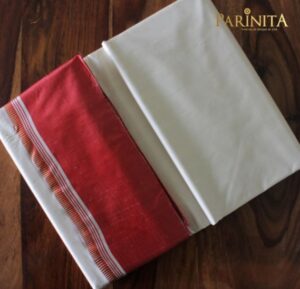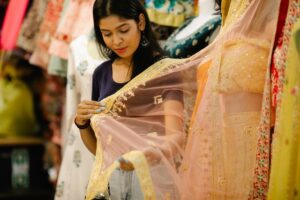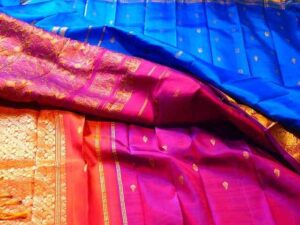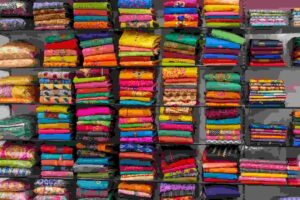Baluchari Silk saree is one of the most exquisite sarees from Bengal. These rich silk sarees are characterized by intricate and rich weaving in the pallu and borders, depicting tales from epics such as Mahabharatha, Ramayan, and historical and religious texts. Baluchari sarees are perfect for weddings, parties, and functions.
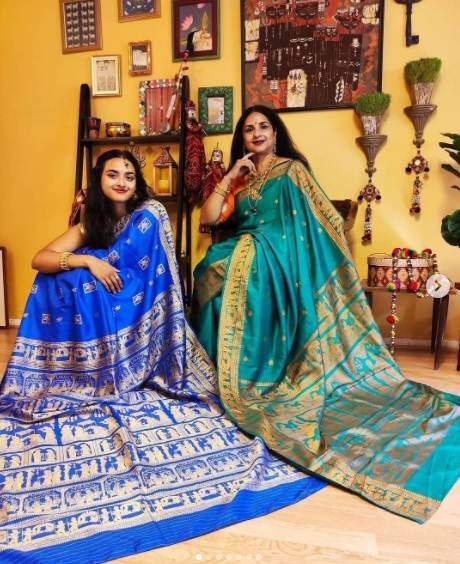
The saree itself bears a traditional and elegant look that makes it an everlasting and eye-pleasing experience for the saree enthusiasts.
Sarees are synonymous with aristocracy and high status in Bengal. These sarees are famous worldwide.
`
History of Baluchari Saree
The origin of Baluchari sarees started to be in a village named Baluchar. Some two hundred years ago, Baluchari used to be practiced in this small village, and from here, the art took its name. The place is located on the bank river of Bhagirathi in Murshidabad district, West Bengal, and is presently known as Jiaganj.
The Bengali royalty has long been associated with the Baluchari silk saree. In the 18th century, art was encouraged and flourished under Murshid Quli Khan, nawab of Bengal.
Baluchari means “sandy river bank.” During that period, the Bhagirathi river was the main waterway for the transportation of various products from one part of Bengal to another.
After a flood in the river and the subsequent submerging of the village, the industry moved to Bishnupur village in the Bankura district.
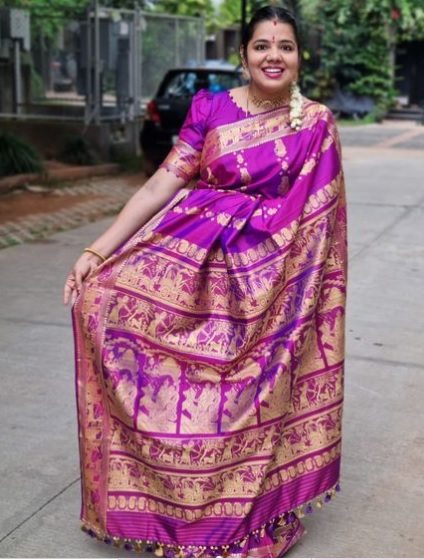
The Malla Kings of Bishnupur were great patrons of handicrafts, art, and culture. During the rule of the Malla dynasty, the sari business flourished at Bishnupur.
However, due to political and financial reasons, this flourishing trend later declined, particularly during British rule. The unique handicrafts of Bengal posed a threat to the British. They forced artists to abandon and switch crafts, resulting in significant losses for handloom weavers and the risk of the skill being ruined.
Subhogendranath, aka Subho Thakur, a notable artist from the Tagore dynasty, took it upon himself to revive this weaving practice in 1956. He taught the Jacquard weaving process to a great weaver named Akshay Das. They both studied the Baluchari saris from Rabindranath Tagore’s family collection.
Akshay then worked relentlessly to develop his expertise and train Bishnupur’s other artisans. As a result, the town resurfaced as a center for weaving the famous Baluchari silk saris.
Mythological stories taken from the walls of temples and woven on Baluchari Sarees are a common feature in Bishnupur.
This way, the Baluchari, and Swarnachari, two different styles of sarees from this Bengali region, were revived.
Types of Baluchari sarees
Baluchari sarees come in a variety of colors and patterns. The weaving pattern, and threads used to make the sarees are used to categorize the various types.
Resham sarees
This is the simplest and most common type of Baluchari sarees. Silk threads in a single color are used to weave the entire pattern of the saree. It gives a simple vintage look to the saree.
Meenakari sarees
Silk threads of two different colors are used to weave the saree under this method. Alternative threads are used to highlight the figures or motifs which is called Minakari Work. The intricate meenakari work adds a touch of flair to the sarees.
Swarnachari sarees
The most gorgeous and magnificent Baluchari saree. Gold or silver color threads are used to weave these sarees, giving them a stunning look. They also have some meenakari embroidery, which highlights the saree’s designs. Brides are increasingly preferring to wear Swarnachari sarees to their wedding reception parties.
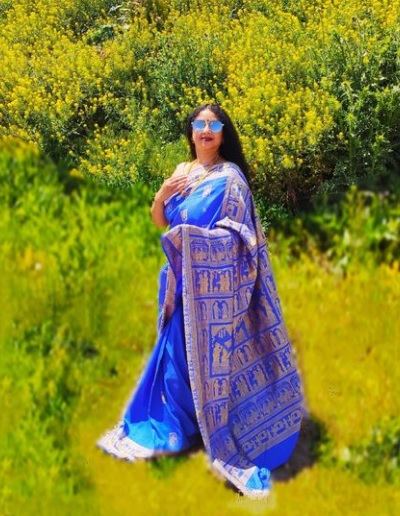
Designs On Baluchari Saree
Baluchari sarees are traditional and represent our culture. It has seen several changes in its making. Every new weaver did it slightly differently.
Sarees have the most elaborate artwork in Resham or Zari threads across the body and pallu. The body has beautiful, intricate motifs of flowers or leaves.
These rich silk sarees have elaborate and rich weaving in the pallu and borders, depicting mythological stories. The designs are influenced by the motifs of terracotta temples in Bishnupur.
Daily life or legendary stories also inspire the scenes of the pallu. A woman fanning herself (a foreigner woman during British control) and a man smoking are also weaved into the pallu.
The pattern and designs of Baluchari sarees have changed over time but their place in the hearts of women did not swift even a little.
The specialty of Baluchari Saree
- Typically, Baluchari Sarees are made of pure silk.
- The pallu design of a Baluchari saree is famed for its mythological stories weaved into it.
- Baluchari Silk sarees have Resham thread incorporated in the weave giving its characteristic rich sheen.
- One saree takes more than a week to complete.
- In 2011, the Baluchari saree received the Geographical Indication Tag (GI).
Tips and Tricks on Styling Baluchari Sarees
Knowing how to style your saree helps bring the best out of your favorite saree. Here are some styling suggestions for Baluchari silk sarees:
- Baluchari sarees complement traditional Indian jewelry beautifully. For a royal effect, pair your saree with gold or ancient gold temple jewelry.
- The pallu is the most beautiful part of a Baluchari saree. Wear your saree in a way that shows off the pallu in all of its splendor.
- Wear your Baluchari sarees with a pair of gold jhumkas for a simple look.
- They have a rich appearance, use a simple or plain blouse design to draw attention to the saree.
- Style these sarees with blouses in contrasting colors for a chic look.
- In a muslin or cotton cover, store the saree. To avoid permanent wrinkles, take your sarees out every three months and refold them.
The weaving of Baluchari Sarees
In older times, there was no machine to help out the workers. These sarees were made only by hand and completed in several days.
Traditional Jala looms were used to weave the original Baluchari sarees in Murshidabad in the 18th and 19th centuries. Jala refers to the reference pattern that is initially made and utilized as the master design from which many copies can be manufactured repetitively for weaving the sarees. The procedure was lengthy, lasting between 15 and 18 weeks to weave a saree, and resulted in a wide range of exquisite patterns.
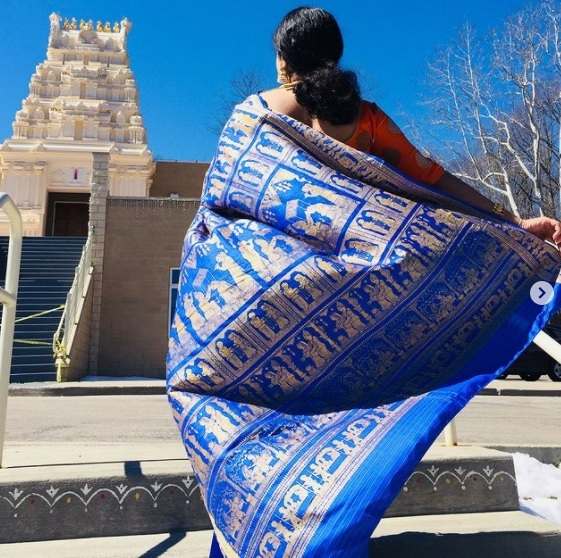
Jala was replaced by the jacquard weaving technique during the artist Subho Thakur’s restoration of Baluchari weaving in the twentieth century. The design is originally sketched on graph paper before being punched into cards. These cards are then placed in sequential order, sewn together, and installed in the jacquard machines.
The jacquard process is easier and faster, reducing weaving time to one or two weeks, but it is less flexible than the Jala approach, and cannot produce designs with as much variety or complexity. That is the technique used to weave Baluchari sarees in recent times.
Presently Baluchari fabrics are woven in Bishnupur of the Bankura district with the jacquard loom. The entire process is done locally, from raising silkworms to spinning and dyeing yarn to designing and making sarees. It takes a long time to create intricate designs and motifs for the border, butis, and pallus of Baluchari sarees.
These weavers are skilled in creating graphs and punching pattern cards. At present, the weaving of a Regular Baluchari saree takes five to six days.
People are shifting towards authenticity again, allowing weavers to return to their profession.
Also Read : The Rise And Fall OF Bengal Silk In India
Where to Buy Baluchari Silk Sarees
There are many duplicate sarees available in the market. Hence, It is recommended to buy only silk mark certified sarees from reputed stores. You can buy Baluchari sarees online or from the best saree shops in Kolkata.
What is the cost of the Baluchari saree?
Baluchari silk sarees are expensive and basic sarees start from Rs. 7000.
